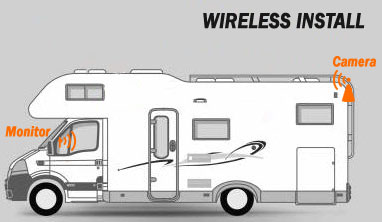Anyone who has been in the drivers seat of a motorhome or vehicle pulling a RV knows the challenges they can reveal themselves when backing the RV into a campsite, garage, parking spot, or driveway. If your one of the lucky few with a late model RV then chances are you have a RV camera or even a series of RV backup cameras to assist you with this task. For the millions of us with “slightly used” RV’s, what are we to do? The answer is to purchase and install an aftermarket RV backup camera. They can be surprisingly affordable and simple to install depending on a slew of factors like RV length, your budget, and the features your looking for.
Aside from assisting RV owners with backing up, the RV rear view camera also helps to eliminate the hated blind spot while in transit as most RV review mirrors serve little to no purpose. The stress associated with changing lanes can be a thing of the past. Having a RV camera gives you an extra set of eyes behind your RV and an awareness that was nearly impossible without it.
What to Look for in a RV Rear View Camera
When you decide its time to get your RV backup camera, there are several factors to consider. Some will be looking for the cheapest options, the most feature rich unit, the unit that most seamlessly integrates with their RV, the best video quality, or perhaps the easiest among them to install. Some RV backup camera units feature remote control, anti-theft features, and wireless installation. As you can imagine, the more features you seek, the larger the price tag.
When You Look, What Will You See
The size of the video monitor (where the image is displayed) will vary from unit to unit. There will also be differences in resolution (crispness of image) in both the video monitor and the RV camera itself. Think of this on a sliding scale. The higher the resolution the more you can see. The more you can see, the higher the price of the RV backup camera system.
Types of RV Cameras
There are two primary types of RV backup cameras available for RV’s. Wired and Wireless. Both run on 12 volt DC power from the RV or vehicle they are attached to. Should you choose to use a wired RV rear view camera system then you will need to run a video cable from the camera to the video monitor which depending on your RV could be 30 feet or more.
Wired RV Camera

A wired RV back up camera is just as the name implies. The connection between camera and video display are connected with a wire that transmits the signal across a large span (the full length of your RV plus the length of your vehicle). A wired RV rear view camera setup tends to be much more “plug and play”. This means that you can buy components separately and they will typically work together even if they are not of the same brand or purchased at the same time. For example you could buy the camera from your neighbor, then purchase the cables online, and purchase the video monitor from the classifieds section. As long as all the components operate under the same video and cable format it should work perfectly. By far the simpler approach is to by a ready made RV back up camera kit. Most RV’ers will find the RV back up camera much less daunting by purchasing a ready made kit.
Wireless RV Camera

Wireless RV rear view camera, also aptly named, include a wireless RV camera as well as a wireless monitor. Each component is performing functions that its wired counterparts do not. The wireless versions are also responsible for transmitting the video image from camera to monitor. The monitor is setup to receive a wireless signal and the camera setup to transmit the signal. The wireless RV backup camera is typically designed only to work with the monitor and camera that it was paired with. Some RV rear view camera systems come with a receiver unit that can be plugged into any video monitor.
